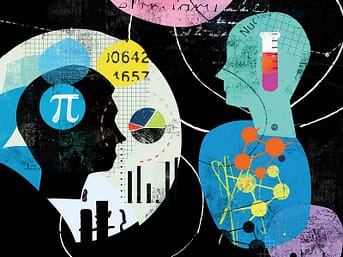
It is hardly surprising that students feel that mathematics is uninteresting when they are plunged into a world of abstraction and numbers.
Howard Gardner proposed a theory of multiple intelligences, suggesting that people have different approaches to learning, such as a visual, kinesthetic or logical approach. This idea expanded people’s thinking about intelligence and competence but was often used in unfortunate ways in schools, leading to the labelling of students as a particular type of learners who were then taught in different ways. But children who are not strong visual thinkers probably need visual thinking more than anyone. Everyone uses visual pathways when we work on mathematics and we all need to develop the visual areas of our brains.
In spite of major breakthroughs in NeuroScience and Psychology on how children learn, mathematics in schools is still presented as a subject of numbers and symbols, ignoring the potential of visual mathematics for transforming students’ learning experiences.
In many countries, students who are weak memorizers or number users are often referred to special education classes even after they produce strong visual ideas and representations in mathematics. This could be the reason that some of our greatest scientists – Albert Einstein and Thomas Edison, for example, were written off by teachers and even labelled as “stupid.” Einstein often shared that all of his thinking was visual and he struggled, later, to turn his visual ideas into words and symbols. [Reference: WestT (2014) Thinking like Einstein: Returning to our visual roots with the emerging revolution in computer information visualization. Prometheus Books, New York].
Visual mathematics is widely thought of as being appropriate for younger or struggling students and as a prelude to the “more important” abstract mathematics. It is true that abstract ideas can come from and be aided by visual mathematics, but visual ideas also come from abstract mathematics and extend them to much higher levels. This is so true today in the fields of big data, AI and advanced computation.
Some of the most interesting and high-level mathematics is predominantly visual. Maryam Mirzakhani made headlines across the world recently when she became the first woman to win the Field’s medal, the greatest prize in mathematics. Her work is almost entirely visual. Mathematicians described her theories as “beautiful”, “stunning” and connecting previously unconnected theories in mathematics.
In recent years, scientists have developed a more nuanced understanding of the ways our brainswork when we study and learn mathematics. Our brains are made up of ‘distributed networks’, and when we handle knowledge, different areas of the brain light up and communicate with each other. When we work on mathematics the brain activity is distributed between many different networks, which include two visual pathways: the ventral and dorsal visual pathways. Different areas of the brain are involved when we think mathematically.
Embodied Cognition is a new and emerging area of research that shows the importance of visual pathways and the connections between different pathways in the brain. Most people think of the mind and the body as completely separate entities with the mind holding knowledge and abstractions, and the body passively taking ideas from the mind to the physical world such as saying ideas out loud or writing them down. But embodied cognition researchers point out that many of our mathematical concepts are held in visual and sensory-motor memories.
It is well known that knowledge of dance, or sport is held in sensory-motor areas of our brain but many would be surprised to learn that mathematics knowledge is also held in sensory-motor memories. We use gestures when we think mathematically. We gesture because we see, experience and remember mathematics physically and visually.
The researchers point out that when we explain ideas, even when we don’t have the words we need, we tend to draw shapes in the air. We might also use space around us to “spread out” our ideas.
Drawing mathematical ideas helps mathematics users of any level, including mathematicians, to formulate ideas and develop understandings.
Mathematics is a multidimensional subject, and problems can be solved with numeric, abstract or visual mathematical pathways. we now know that our brain networks are correspondingly multi-dimensional and need to be developed and used.
References:
Menon V (2014) Arithmetic in child and adult brain. In: Cohen KR, DowkerA (eds.) Handbook of mathematical cognition. Oxford University Press, London.
Schneider M, Grabner RH, Paetsch J (2009)Mental number line, number line estimation, and mathematical achievement: Their interrelations in grades 5 and 6. Journal of Educational Psychology.
